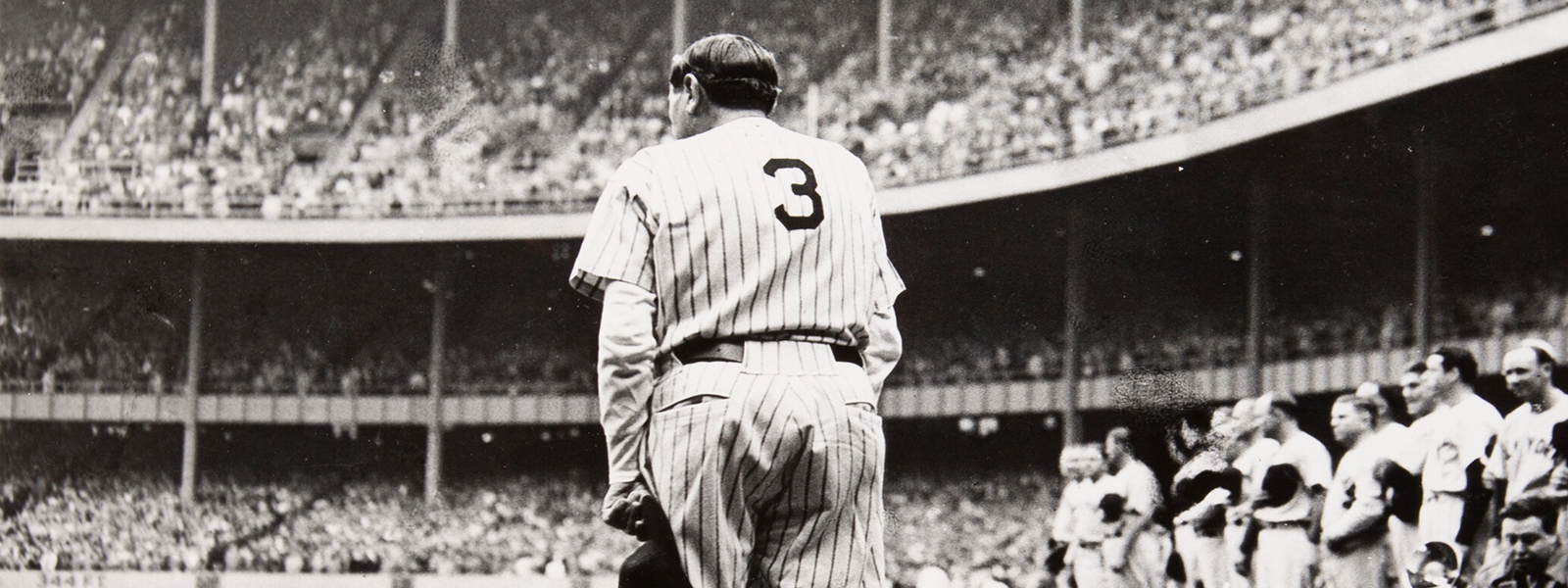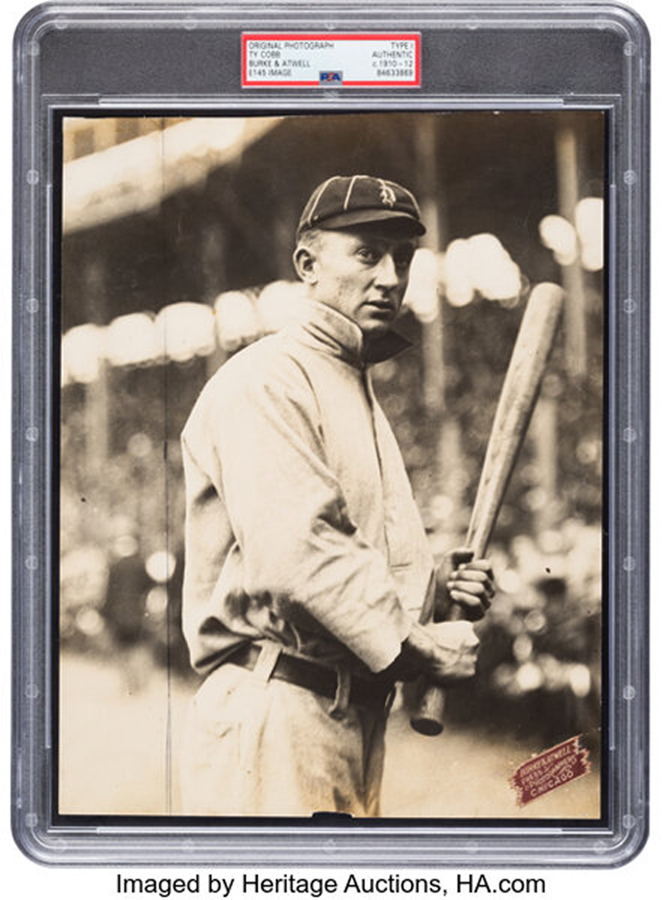KNOW THE KEY FACTORS THAT CAN IMPACT A PHOTOGRAPH’S APPEAL AND VALUE
By Joe Orlando
During the past several years, the market for vintage sports photographs has changed dramatically as more collectors have been exposed to this intriguing genre. Vintage photos offer a combination of scarcity and aesthetic beauty and, most important, capture a singular moment better than any other collectible type. A photo doesn’t represent a mere era, year, day or game. It captures a fraction of a second, frozen in time.
As the adage goes, a picture may be worth a thousand words, but today it is not uncommon for an iconic photo to also be worth well over six figures and beyond. Collectors have come to appreciate all the appealing attributes of these once-hidden gems that are clearly hidden no more. Items that were often viewed as complementary pieces have now become centerpieces in some of the finest collections in the hobby.
Unlike the trading card world, where resources are readily available to the hobbyist, information about vintage sports photos is limited as the market is still in its infancy compared with more mature segments of the sports collectibles industry. It is a world that remains relatively unexplored by the masses, which can be viewed as an opportunity for collectors looking to expand their horizons.
For those interested in exploring vintage sports photo collecting, we present a hobby guide containing the key factors that can impact demand and, ultimately, value.
Enlarge

Certification: Familiarize Yourself With the Photo Type Classification System
As with other collectible fields or genres, third-party authentication and grading services have become a critical component in the sports photograph world. Unlike the grading system for trading cards, however, the most vital type of certification performed in the vintage photograph market is not an evaluation of condition.
Instead, a method known as the Photo Type Classification System© was created by photography experts Henry Yee and Marshall Fogel in 2005. The system categorizes a specified photo into one of four Types and defines that photo’s two key components: its origin (whether the photo was made from the original negative or a duplicate) and its vintage (when the photo was made).
Each Type within the classification system is described as follows:
Type I: A 1st generation photograph, developed from the original negative, during the period (within approximately two years of when the picture was taken)
Type II: A photograph, developed from the original negative, during the period (more than approximately two years after the picture was taken)
Type III: A 2nd generation photograph, developed from a duplicate negative or wire transmission, during the period (within approximately two years of when the picture was taken)
Type IV: A 2nd generation photograph (or 3rd or later generation), developed from a duplicate negative or wire transmission, during a later period (more than approximately two years after the picture was taken)
As one would expect, the most desirable photographs are of the Type I variety because they are considered “original” in the purest sense. A Type I photograph was developed around the time it was taken. If all else is equal regarding the attributes of a photograph, a Type I will consistently sell for a major premium versus Type II through Type IV specimens. Some Type II photographs where the image is considered iconic or historically significant have garnered noteworthy prices, but the range of value within this classification can be substantial since the dating of their development can vary immensely.
There are instances where a Type I photograph of a particular image has not yet been discovered and, as a result, an example that ranks lower on the classification chart becomes the finest known by default. In cases like this, the photograph has the potential to break free of the general valuation rule, regardless of Type. This principle applies to every segment of collecting.
Key takeaway: While Type II-Type IV photographs can offer affordable alternatives, Type I is the classification prized most by collectors.
Enlarge
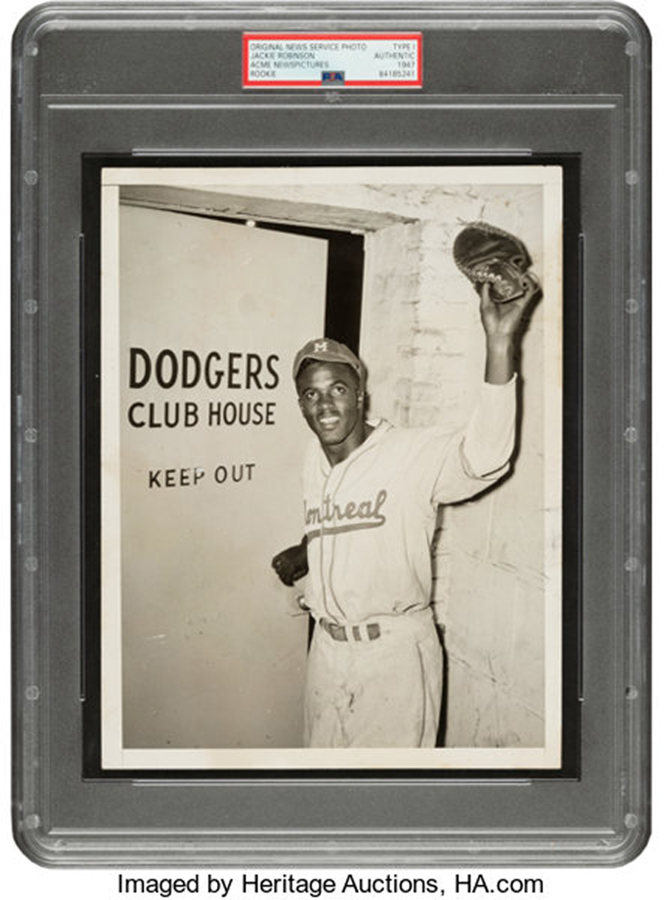
Condition: Learn How “Grade” Impacts Value
The Type classification system for photographs does not consider condition as part of the process. That said, condition does matter. The evaluation, however, is far less technical than the grading approach used in the trading card market. Generally, experienced photograph collectors are focused on overall eye appeal, not the type of defects that have negligible impact on the image at the center of the piece.
Aside from studio photographs made for personal consumption, most surviving copies were used by newspapers and media outlets as instruments to capture, illustrate and document history. To bring everyday moments and major events to life, the typical process required various individuals to handle the photographs. From developers to postal workers to newsroom personnel, each photograph embarked on its own journey, which is part of its story. In addition to the general wear from handling, photographs often exhibit editorial notations and crop marks and were sometimes cut to modify their size.
Condition becomes increasingly relevant if the kind of flaws detected detract from the visual presentation of the image. If your eyes are drawn to the flaws from the outset, then condition becomes a problem because your attention is being diverted away from the image. Since most photographs are larger than trading cards, they can be enjoyed in an entirely different way. They are collectibles, but they are also display pieces. Due to their size and content, they are often appreciated like other forms of art.
Consequently, defects such as corner wear or minor surface wrinkles, the kind that could knock a trading card down into the lower half of the grading scale, do not have anywhere near the same, negative effect here.
Key takeaway: Condition matters only if the flaws present distract the viewer from the artistry found within the photograph’s edges.
Enlarge
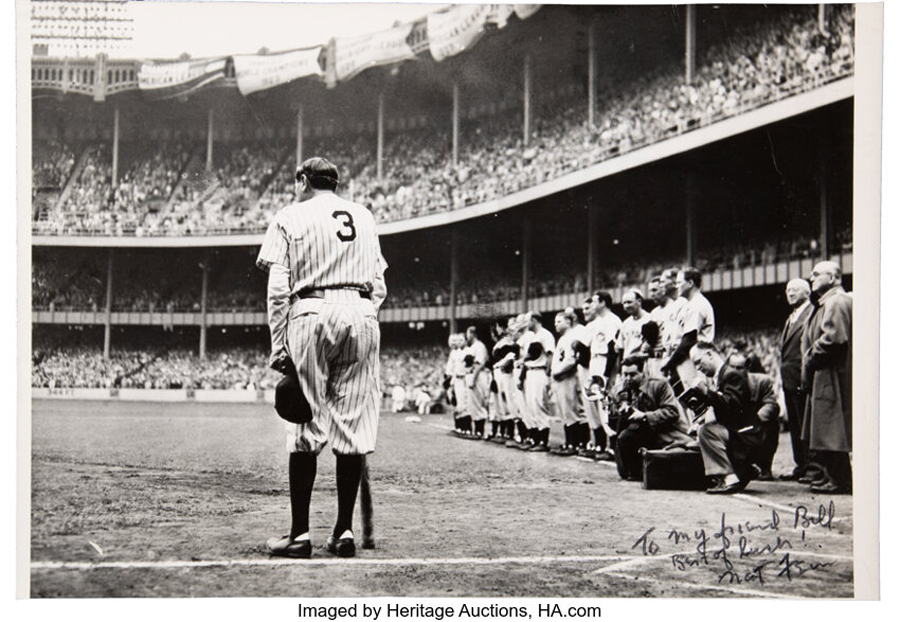
Content: The Subject Is the Chief Driver of Value
As is the case with everything else in collectibles, the item’s link to a particular person, group or subject is often what makes it desirable. The subject of each photograph takes center stage, and the legends of sport usually own that stage when it comes to market demand. The historical importance and popularity of the main subject are what usually operate as the lure. There is typically an enormous difference in value between a photograph of Babe Ruth and Babe Adams, no matter who was behind the camera.
But a connection to a renowned photographer can add value to a piece. For example, George Bain, Charles M. Conlon, Carl Horner and Paul Thompson are recognized in photography circles for their work in baseball during the first half of the 20th century. Their followings should not be overlooked, but the reality is most photographs are not connected to well-known brands like the ones above. Iconic status is often achieved by the image itself. The terrific The Babe Bows Out image taken by Nat Fein in 1948, one that earned him a Pulitzer Prize, is a fitting example. While nearly all the work associated with a photographer can possess a certain cachet, most images earn prestige on their own merit.
In fact, the photographers behind many iconic images are unknown since credit often was not given to the individuals capturing the image. The news agencies collaborated with staff photographers and freelancers, but the names behind the camera were seldom identified when the photos were used or printed. Trade associations and legal protections that exist today were not available to photographers, or enforced, during the time when most vintage images were taken. On the other hand, the content of a photograph can always be deciphered, which is why it is the crux of valuation.
Key takeaway: The content of every photograph is the leading factor in value, no matter what the central figure is doing, who captured the image or how the image was used.
Enlarge
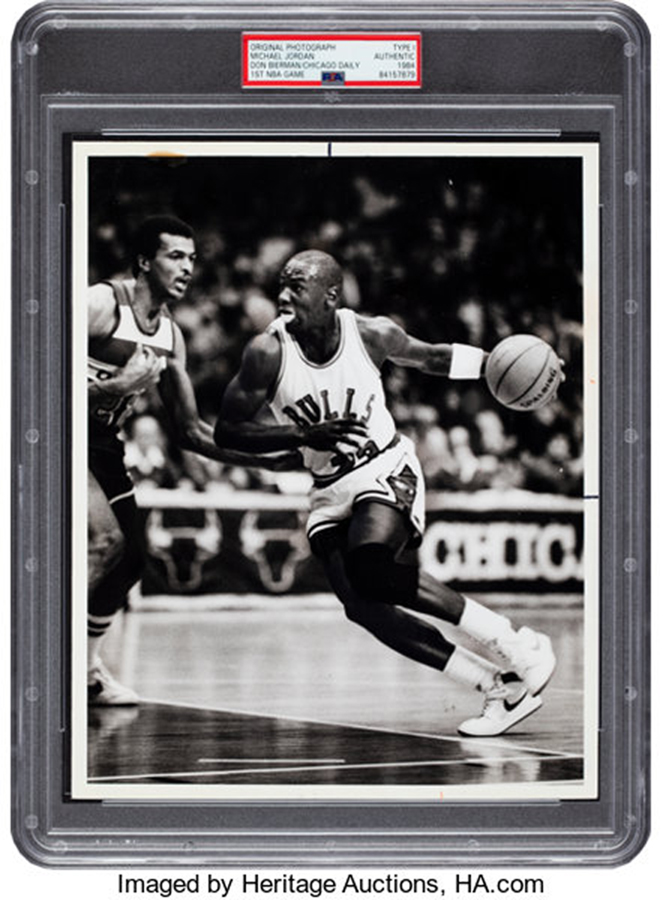
Context: The Circumstances Surrounding the Subject Are Crucial
Once the content, or subject, of the photograph is evident, the most relevant valuation factor has been established. The assessment, however, does not end there. Unlike trading cards, where the market is far more defined, some degree of subjectivity is unavoidable when it comes to deciding where one photograph ranks versus another. Identifying photographs that might be considered elite can be challenging because of the number of potential variables in play, yet there is a method to determining value. This level of complexity makes collecting photographs fascinating.
After content, the context of the photograph is what needs to be evaluated next. In other words, what are the circumstances (or context) surrounding the subject (or content) in the photograph? How is the content being presented? What is the subject doing? How is the subject being depicted or portrayed? Remember, the beauty of a photograph is that it captures an exact moment in time. That moment is the context collectors need to examine.
For example, if a collector is considering the purchase of a Type I Babe Ruth photo, there are some key questions to ask about the context of the photo even after the main subject is clear. Is Ruth captured in uniform or in street clothes? Was the photo taken during Ruth’s playing career or afterward? Does the image link to a significant moment in Ruth’s life, or is the image random in nature? Is the photo a studio-quality image that embodies the essence of Ruth’s personality, or is the photo an in-action shot that showcases Ruth’s skill? Was the image of Ruth used for other purposes, such as trading card design? Is Ruth pictured by himself or with others?
These are merely sample queries about context, but they are all representative of the sort of questions one should ask before buying.
Over the past few years, as with other collectibles such as trading cards and tickets, photos tied to an athlete’s first appearance, rookie year or early career have become extraordinarily desirable.
Key takeaway: The context of the photograph is the fuel behind the valuation fire created by the subject.
Enlarge
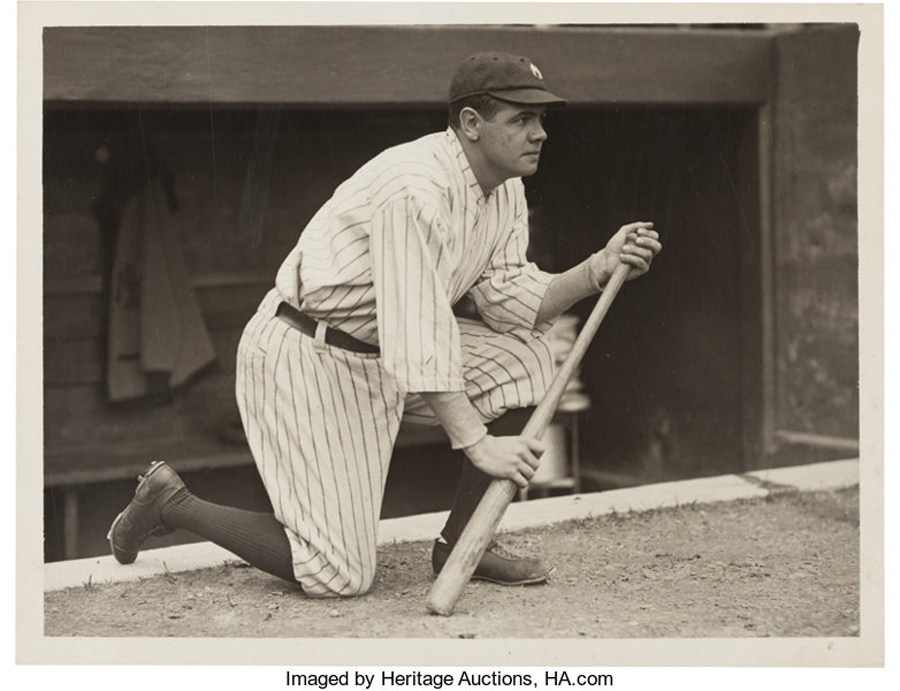
Clarity and Contrast: The Eye Appeal of the Image Acts as the Draw
If you appreciate fine art of any kind, then you are already familiar with this principle. This is especially true when it comes to abstract art and the effect it can have on the viewer. Photography is an art form. Just like the work of a painter or sculptor, a photographer’s creation can draw you in by the mere sight of it. You need not know the artist’s name, when the photo was created or how it was accomplished. You simply know that it is pleasing to the eye in a way that might be hard to describe. Furthermore, what your eyes are processing is also being processed internally, which can lead to an emotional response to the piece.
The eye-appeal principle is universal in the collectibles world, but its relevance increases depending on the type of item. Since photos are often large enough to be used as display pieces, this is a subject of extreme importance. In fact, the sheer size of the photograph can enhance its potency as a display piece. The combination of two key attributes, the clarity and contrast of the image, can create the kind of visual allure that pulls a person in. Much of the time, a strong showing of one without the other is not enough to create the optimal aesthetic.
Think of clarity like one would view registration in the trading card world. The sharper the image, the greater the detail, the more pleasing the photograph becomes. If an image is crystal clear, it can transport the viewer to that exact moment like a time machine. Contrast, on the other hand, is best described as how the central image pops or stands out in the shot. Great contrast requires separation between the foreground and background.
Sometimes, excellent contrast or a lack thereof is created when the photograph is born, a simple product of what is contained in the original image. Other times, contrast is affected at the point of development, which is why not every printed copy looks the same. Mishaps such as overexposure can create inconsistency in strike quality.
Key takeaway: If a photograph exhibits superb clarity and contrast, it can bring the legends of the past back to life.
Whether you are in search of the iconic figures who capture our imaginations or the special moments that helped shape sports history, we hope this guide proves useful on your collecting journey.
 JOE ORLANDO is Executive Vice President of Sports at Heritage Auctions.
JOE ORLANDO is Executive Vice President of Sports at Heritage Auctions.
He can be reached at JoeO@HA.com or 214.409.1799.

